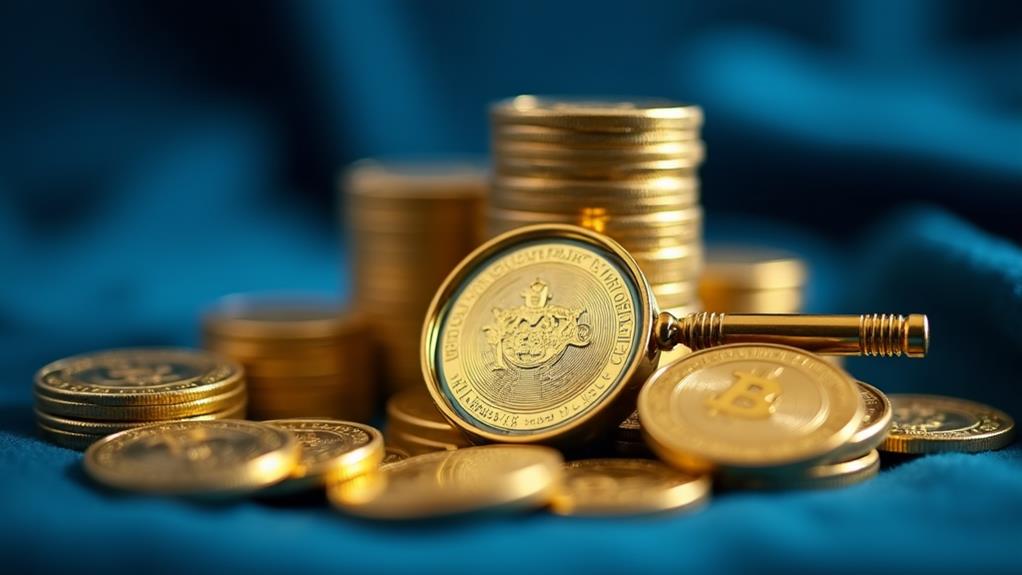Investing in gold coins can be a lucrative endeavor, but it requires careful consideration and strategic planning. While many are drawn to the allure of precious metals, particularly during times of economic uncertainty, not all gold coin investments yield the same results. To traverse this complex market successfully, investors must arm themselves with knowledge and adopt a methodical approach. By following these seven essential tips, both novice and experienced collectors can position themselves to make informed decisions, potentially maximizing their returns while minimizing risks. The world of gold coin investment is multifaceted, and understanding its nuances is vital for those seeking to build a sturdy portfolio.
Key Insights
- Research and choose reputable dealers to ensure authenticity and competitive pricing of gold coins.
- Understand gold characteristics, including purity, weight, and rarity, to make informed investment decisions.
- Diversify your portfolio with a mix of bullion and numismatic coins from various regions and time periods.
- Stay informed on market trends and factors influencing gold prices to optimize investment strategies.
- Implement secure storage solutions and consider insurance to protect your physical gold assets.
Research Reputable Dealers

Investors seeking to purchase gold coins must prioritize researching reputable dealers before making any transactions. This critical step in a smart investment in gold coins ensures authenticity and fair pricing.
Begin by conducting thorough market research on established dealers specializing in gold bullion coins and precious metals. Verify their credentials, certifications, and customer reviews to gauge reliability. Reputable dealers often provide transparent information about gold coin premiums, investment strategies, and physical gold storage options.
Compare prices and services across multiple dealers to identify competitive offers. Be cautious of deals that seem too good to be true, as they may involve counterfeit products or hidden fees.
Consult expert opinions and industry publications for insights on current gold prices and market trends. By carefully selecting a trustworthy dealer, investors can confidently add gold coins to their investment portfolio, mitigating risks associated with fraudulent transactions.
Understand Purity and Weight
Understanding the purity and weight of gold coins is vital for smart investing.
Investors must familiarize themselves with both karat and fineness scales to accurately assess gold content, as these measurements directly impact a coin's value.
Moreover, comprehending the concept of troy ounces, the standard unit for precious metals, is fundamental for comparing prices and making informed purchasing decisions.
Karat Vs. Fineness Scales
When exploring the world of gold coin investments, understanding the concepts of karat and fineness scales is crucial. These measurements determine the purity of gold content in coins, directly impacting their value and relationship to the gold spot price. The karat scale ranges from 0 to 24, with 24 karat representing pure gold. Alternatively, the fineness scale expresses purity as parts per thousand. Popular gold coins like the Canadian Gold Maple Leaf and American Gold Eagle have different purities, affecting their gold content and price.
| Coin Type | Karat | Fineness |
|---|---|---|
| Gold Buffalo | 24K | .9999 |
| Krugerrand | 22K | .9167 |
| Gold Eagle | 22K | .9167 |
Investors should carefully consider these factors when choosing physical gold or gold bullion for their portfolios. Understanding purity scales helps ensure informed decisions and maximizes the potential return on investment.
Troy Ounces Explained
For gold coin investors, the troy ounce serves as the standard unit of measurement for precious metals. This system, distinct from the avoirdupois ounce used in everyday life, is vital when calculating the value of gold coins, silver coins, and other precious metal investments. One troy ounce equals approximately 31.1 grams, slightly heavier than a standard ounce.
When you buy gold or invest in coins and bars, understanding troy ounces is fundamental for accurate pricing. The price of gold is typically quoted per troy ounce, affecting the value of your coins stack or gold bars.
As John Smith, a precious metal expert, explains, "Investors must be alert about troy ounce measurements when comparing prices or assessing their portfolio's worth."
Consider Rarity and Collectibility

Beyond their inherent precious metal value, gold coins can derive significant worth from their rarity and collectibility. When evaluating gold as an investment, it's vital to understand that coins or bullion offer a tangible form of physical gold.
Nevertheless, certain coins are likewise prized for their historical significance or limited mintage. To maximize long-term value and investment diversification, contemplate these factors:
- Mintage numbers: Lower production quantities often correlate with higher collectible value.
- Condition: Well-preserved coins typically command higher premiums.
- Historical significance: Coins from notable eras or with unique stories can be more desirable.
While gold prices tend to be volatile in the short term, rare and collectible coins may offer additional stability.
Yet, it's essential to note that the market for such coins can be complex, requiring careful research and expert guidance before deciding to buy gold coins.
Diversify Your Coin Portfolio
Diversifying your gold coin portfolio is an essential strategy for minimizing risk and maximizing potential returns.
A well-balanced collection should include a mix of coin types, such as bullion coins for their gold content and numismatic coins for their historical value and rarity.
Broadening your portfolio to include coins from different geographical regions and time periods can further improve its resilience and growth potential.
Mix Coin Types
A well-rounded gold coin portfolio encompasses various coin types, each offering unique benefits and potential returns. When investing in physical gold, consider mixing:
- Bullion coins: These offer the closest price to spot gold and are ideal for those focused on gold content.
- Numismatic coins: Rare or collectible coins that may appreciate beyond their gold value.
- Semi-numismatic coins: A balance between bullion and collectible value.
Diversifying across these types can help mitigate risks and maximize potential gains.
When deciding between bars or coins, keep in mind that coins often offer more liquidity and flexibility. The amount of gold you invest in each type depends on your investment goals and risk tolerance.
Owning gold in different forms provides various ways to invest, allowing you to adapt to market changes. Consider consulting a financial advisor to determine the optimal mix for your portfolio.
Balance Historical and Modern
Striking a balance between historical and modern gold coins can significantly improve your investment portfolio's diversity and potential. This approach combines the allure of rare, historical pieces with the liquidity of contemporary issues. Consider the following comparison:
| Aspect | Historical Coins | Modern Coins | Balanced Approach |
|---|---|---|---|
| Value | Numismatic | Bullion | Both |
| Liquidity | Lower | Higher | Moderate |
| Risk | Higher | Lower | Balanced |
| Appreciation | Potentially higher | Steady | Mixed |
| Diversification | Limited | Limited | Comprehensive |
Consider Geographical Diversity
Your gold coin portfolio can benefit greatly from geographical exploration. Diversifying across regions can mitigate risks associated with economic fluctuations and provide exposure to various gold markets.
Consider incorporating coins from:
- North America (e.g., American Gold Eagles)
- Europe (e.g., British Sovereigns)
- Asia (e.g., Chinese Gold Pandas)
Geographical diversity offers investors protection against currency fluctuations and regional economic instability.
When determining whether gold is a good investment, consider the global landscape of gold reserves and production. Different regions may have unique minting techniques, cultural significance, or historical value attached to their gold coins. This diversity can improve your portfolio's resilience and potential for appreciation.
Nevertheless, be cautious when deciding to buy or sell gold directly from international sources. Research import regulations and authenticity verification methods to ensure your investment's legitimacy and value.
Stay Informed on Market Trends

To make informed decisions when investing in gold coins, staying up-to-date with market trends is vital. Gold prices fluctuate based on various factors, including economic conditions and geopolitical events.
Market timing can be challenging, as gold is often considered a safe-haven asset during uncertain times. Gold ETFs and physical gold demand likewise influence prices. Understanding how gold is trading in relation to other assets is important.
Gold is typically viewed as a hedge against inflation and currency devaluation. As gold has become more accessible to retail investors, its price movements have become more complex.
Rising gold prices may indicate economic uncertainty, while falling prices could suggest improving market conditions. Investors should monitor global economic indicators, central bank policies, and industrial demand for gold to make informed decisions about their gold coin investments.
Secure Proper Storage Solutions
Securing proper storage solutions is vital when investing in gold coins. Physical gold assets require careful consideration to protect their value and ensure their safety. Gold stored improperly can be susceptible to theft, damage, or loss.
Gold companies often offer storage services, but investors may prefer to manage their own security.
When deciding how to store gold, consider these options:
- Home safe: Provides immediate access but may not offer sufficient protection
- Bank safe deposit box: Offers improved security but limited accessibility
- Private vault storage: Combines high security with flexibility, often used for gold IRAs
Gold without proper storage can be risky. Gold can likewise be insured, adding an extra layer of protection.
As gold comes in various forms, storage needs may vary. Gold is seen as a long-term investment, therefore choosing the right storage solution is fundamental to add gold to your portfolio safely and securely.
Plan Your Exit Strategy

Every successful investment strategy includes a well-planned exit approach.
When investing in gold coins, consider your portfolio allocation and the cost of entry.
Determine under what circumstances you'll sell, such as when the market price of gold reaches a certain level or when your reasons to buy no longer apply.
Consider alternative options for liquidating your investment, such as:
- Converting to gold ETFs or gold mutual funds
- Investing in stocks of gold miners or gold mining stocks
Dr. Jane Smith, financial analyst, advises, "Always have multiple exit strategies ready. Market conditions can change rapidly, affecting the value of your gold investment."
My Final Thoughts
A smart investment in gold coins requires careful consideration of multiple factors. The case of John Smith, who diversified his portfolio with both bullion and rare coins, illustrates the potential benefits of this approach. By following the essential tips outlined, investors can steer through the intricacies of the gold market more effectively. Nevertheless, it's vital to remain alert, stay informed about market trends, and adapt strategies as needed to maximize returns while minimizing risks in this volatile yet potentially rewarding investment arena.







